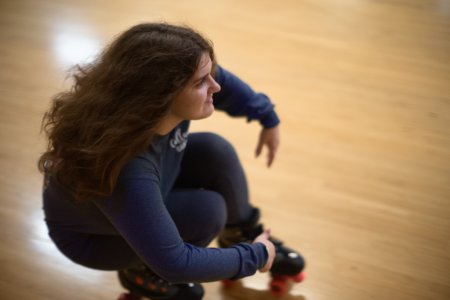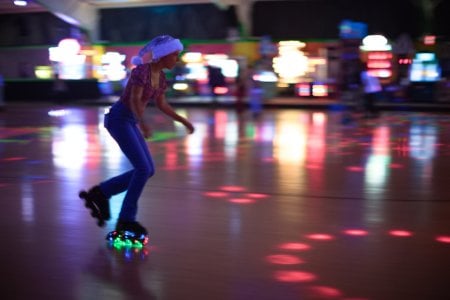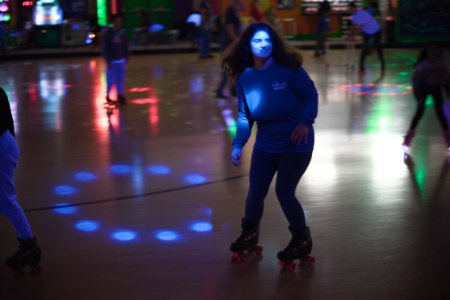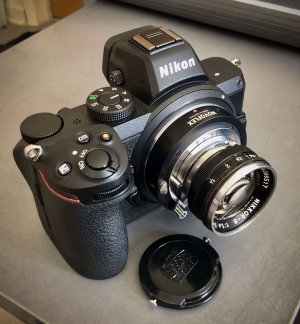Ricoh
Well-known
It’s a question really. I’ve noticed a Z6 at a dealer and wondering how easy or difficult to focus manual lenses (with appropriate adapter of course). Do you have to menu dive to find the pixel ‘blinkies’, ‘zebra patterns’ or whatever they’re called in Nikon Z world. The other question is to do with screen/EVF brightness to compensate when stopping down, and the focussing assist under stopped down conditions?
Thanks for your help.
Thanks for your help.
GMOG
Established
I have a Z5, but I believe the cameras differ little in how one uses them for vintage manual focus lenses. After buying any modern digital camera I recommend sitting down with the user guide and going through all the menu items to become familiar with them.
A nice touch built into these cameras is the ability to assign certain functions to the buttons on the top, front, and back of the camera. I never use the video function, so I programmed the video record button on top of the camera to access " Choose non-CPU lens number". I don't use AF lenses, so I programmed the "AF-ON" button on the back to kick in the close-up focus option.
Re "menu diving": Once you identify the menu items you want to access more easily you can add them to "My Menu". This eliminates the need to hunt through all the menu items when looking for those settings you want easy access to.
Does your question about "screen/EVF brightness to compensate when stopping down" have to do with the screen getting brighter/darker as you make changes to aperture and shutter speed? If so, you can turn it on/off in Custom Setting Menu, "d7 - Apply settings to live view". I found this feature to be annoying, as it was interfering with my use of the meter. I'm familiar enough with Nikon's traditional center-weighted metering scheme, but using the screen as a metering aid did not work for me. I kept missing exposure because the screen's version of what the exposure was going to look like did not translate well to reality. So I turned it off and haven't missed it.
Re focus peaking: I found it to be less than helpful, so I don't use it much. The screens are good enough for focusing, especially when using the close-up option, which allows for a variety of zoom factors depending on need/desire.
A nice touch built into these cameras is the ability to assign certain functions to the buttons on the top, front, and back of the camera. I never use the video function, so I programmed the video record button on top of the camera to access " Choose non-CPU lens number". I don't use AF lenses, so I programmed the "AF-ON" button on the back to kick in the close-up focus option.
Re "menu diving": Once you identify the menu items you want to access more easily you can add them to "My Menu". This eliminates the need to hunt through all the menu items when looking for those settings you want easy access to.
Does your question about "screen/EVF brightness to compensate when stopping down" have to do with the screen getting brighter/darker as you make changes to aperture and shutter speed? If so, you can turn it on/off in Custom Setting Menu, "d7 - Apply settings to live view". I found this feature to be annoying, as it was interfering with my use of the meter. I'm familiar enough with Nikon's traditional center-weighted metering scheme, but using the screen as a metering aid did not work for me. I kept missing exposure because the screen's version of what the exposure was going to look like did not translate well to reality. So I turned it off and haven't missed it.
Re focus peaking: I found it to be less than helpful, so I don't use it much. The screens are good enough for focusing, especially when using the close-up option, which allows for a variety of zoom factors depending on need/desire.
Last edited:
Ricoh
Well-known
Thank you for your detailed reply. I’ve used Oly M4/3 with manual focus non CPU lenses, but found the lack of spontaneity and shifting from normal to enlarged view a bit disorienting when trying to focus quickly. I learn from that there’s not much to compare with the rangefinder. No wonder it has survived so long in the digital world of Ms.I have a Z5, but I believe the cameras differ little in how one uses them for vintage manual focus lenses. After buying any modern digital camera I recommend sitting down with the user guide and going through all the menu items to become familiar with them.
A nice touch built into these cameras is the ability to assign certain functions to the buttons on the top, front, and back of the camera. I never use the video function, so I programmed the video record button on top of the camera to access " Choose non-CPU lens number". I don't use AF lenses, so I programmed the "AF-ON" button on the back to kick in the close-up focus option.
Re "menu diving": Once you identify the menu items you want to access more easily you can add them to "My Menu". This eliminates the need to hunt through all the menu items when looking for those settings you want easy access to.
Does your question about "screen/EVF brightness to compensate when stopping down" have to do with the screen getting brighter/darker as you make changes to aperture and shutter speed? If so, you can turn it on/off in Custom Setting Menu, "d7 - Apply settings to live view". I found this feature to be annoying, as it was interfering with my use of the meter. I'm familiar enough with Nikon's traditional center-weighted metering scheme, but using the screen as a metering aid did not work for me. I kept missing exposure because the screen's version of what the exposure was going to look like did not translate well to reality. So I turned it off and haven't missed it.
Re focus peaking: I found it to be less than helpful, so I don't use it much. The screens are good enough for focusing, especially when using the close-up option, which allows for a variety of zoom factors depending on need/desire.
MarkWalberg
Established
I've been using a Z6 for a year and a half, almost exclusively with manual focus lenses, some Nikon, but many others. I find that the close up focus feature to be terrific for things not moving very fast. As GMOG says, you need to program one of the easily reached buttons to activate it when you want it. The focus peaking is helpful in some situations, but the close focus is better if your subject gives you the time to use it. Brian Sweeney has pointed out that the focus peaking is great for faster moving subjects (e.g., his skaters) because you can hit the release when the subject turns red. I've found the Z6 to be one of my all time favorite manual focus cameras, and I've used a lot of them. At very high iso, the close up focus is a little harder to use, at 51k for example, because the viewfinder image is not as sharp then.
The Z6 and Z5 have the same viewfinder. Focus peaking is incredibly easy to use. I have an easier time focusing on moving subjects with the Z5 and manual focus lenses than I do with the Df, which I bought first day available and still have,
I don't have any AF lenses with my Z6, and I have found it very satisfying to use. I have used MF lenses on mirrorless since way back in 2008 when the very first mirrorless camera was released, the Panasonic G1. This was before any lens adapters were commercially available...first one, I had to make myself.  Subsequently I used adapted lenses on Fuji and Sony mirrorless.
Subsequently I used adapted lenses on Fuji and Sony mirrorless.
The Z6 viewfinder has 3.6mp and is excellent for this purpose.
On the Z6, I have assigned the zoom feature to the AF-ON button and use focus peaking.
Also, recently obtained a Megadap Leica M to Nikon Z AF adapter, which offers autofocus with manual focus Leica M lenses. This adapter, in combination with a Nikon to Leica M adapter, allows AF with Nikon F mount lenses. I also use it with a Contax/Yashica to Leica M adapter.
The AF isn't particularly fast, certainly nowhere near the speed of a native AF Z-mount lens, but it's very accurate, and my type of photography doesn't need fast AF anyway. This adapter eliminates the need to use the zoom feature or focus peaking.
Unfortunately these adapters are discontinued, I found mine used on ebay, sold by keh.
The Z6 viewfinder has 3.6mp and is excellent for this purpose.
On the Z6, I have assigned the zoom feature to the AF-ON button and use focus peaking.
Also, recently obtained a Megadap Leica M to Nikon Z AF adapter, which offers autofocus with manual focus Leica M lenses. This adapter, in combination with a Nikon to Leica M adapter, allows AF with Nikon F mount lenses. I also use it with a Contax/Yashica to Leica M adapter.
The AF isn't particularly fast, certainly nowhere near the speed of a native AF Z-mount lens, but it's very accurate, and my type of photography doesn't need fast AF anyway. This adapter eliminates the need to use the zoom feature or focus peaking.
Unfortunately these adapters are discontinued, I found mine used on ebay, sold by keh.
Ricoh
Well-known
I was thinking of the new Zf because of ergonomics and because it looks nice. The price differential makes the Z6 more attractive, though. Given the camera in question from the dealer comes with a 15 day return period, plus 6 month’s guarantee I suppose I could order and send it packing if I don’t gel with it. But, I would need a Z to F to try it out, so some of the initial trial period will go flying. What I’ve heard here is encouraging I must say.The Z6 and Z5 have the same viewfinder. Focus peaking is incredibly easy to use. I have an easier time focusing on moving subjects with the Z5 and manual focus lenses than I do with the Df, which I bought first day available and still have,
GMOG
Established
Thought I would add that when using the close-up focus aid the zoom factor is adjustable using the +/- buttons on the back.
I can see how focus peaking could be useful for faster action, as noted above. I'll remember that and try it out when the situation arises.
I can see how focus peaking could be useful for faster action, as noted above. I'll remember that and try it out when the situation arises.
Last edited:
Ricoh
Well-known
That’s very kind to offer. I’m in the U.K. so if I decide on the camera I’ll order maybe a K+F as they seem to be affordable.@Ricoh I have a Nikon F to Z adapter you can use, if you're in the states.
The F to Z mount adapters that I use were ~$15.

I bought two.
Nikkor 55/1.2 Ai, wide-open on the Z5.



Focus using focus peaking is easy, Shutter Latency is low. I cannot do this using the M240 in Liveview mode with the EVF2.

Pro Nikon F Mount Lens to Nikon Z5 Z30 Z50 Z5 Z6 Z7 II Mirrorless Camera Adapter | eBay
Fits Nikon F Mount lens. With lens lock pin and stop screw. Exposure and focus has to be adjusted manually. Precise design, fine finishing! Install, remove and operate lens smoothly! We really appreciate that.
www.ebay.com
I bought two.
Nikkor 55/1.2 Ai, wide-open on the Z5.



Focus using focus peaking is easy, Shutter Latency is low. I cannot do this using the M240 in Liveview mode with the EVF2.
maryland_fotos
Well-known
Not sure if focus peaking is always very precise, you have to fiddle with the settings. In a complex image it can be hard to gauge the exact focus plane among the various areas that get highlighted. And if something's the same colour as the highlight colour you choose, then that's an additional challenge.
Enlarging the image while at the focus point is very helpful, only thing while working with that + button I end up moving the camera back or forth. You also have to then use the - button to get rid of the enlargement and make sure you didn't lose the framing. The Zf improves this experience somewhat. This feature works best with a tripod.
I wouldn't mind getting that green focus dot from the Nikon DSLRs back in their mirrorless. Some folks didn't have good results with it, but I thought it was pretty consistent and precise.
Enlarging the image while at the focus point is very helpful, only thing while working with that + button I end up moving the camera back or forth. You also have to then use the - button to get rid of the enlargement and make sure you didn't lose the framing. The Zf improves this experience somewhat. This feature works best with a tripod.
I wouldn't mind getting that green focus dot from the Nikon DSLRs back in their mirrorless. Some folks didn't have good results with it, but I thought it was pretty consistent and precise.
MarkWalberg
Established
Another point that is worth knowing on the Z6. The little square that shows the focus point can move around on the screen to various points. You can program, in the menus, the button that controls this focus square to bring the square back to the center when the center of the button is pushed.
It took me a long time to figure out how to do this, but it made the close focus function markedly more useful.
It took me a long time to figure out how to do this, but it made the close focus function markedly more useful.
Benjamin Marks
Mentor
I am finding that I can take all kinds of pictures with these new Z-mount machines that I couldn't take before. Want to do a face off between a 1950's Contax and a modern Nikon RF lens using the same Amadeo adapter? No problem. Want to take a handheld picture with a 90/2.8 skinny Elmarit indoors with the lights off? Also no problem. Want a single platform for all of your M, LTM, AiS, AR, K-mount etc. lenses? Also not a problem. That right there is what I call an advance in the art. Now if I could just take pictures that were worthy of all this new techno-goodness. I am working on that last part.Focus using focus peaking is easy, Shutter Latency is low. I cannot do this using the M240 in Liveview mode with the EVF2.
BTW, I agree with all the comments above about magnification over focus peaking in general. But for a moving target? The focus peaking sounds like the way to go. Nice photos Brian!
GMOG
Established
Benjamin Marks
Mentor
Sweet! Bet that Nikkor delivers stunning results.
Timmyjoe
Mentor
Similar to what Greg did, I bought a Z6 to use exclusively with my 1950's Nikkor S lenses. Had no problem manual focusing with them. I like the zoom in focus technique. Worked great. Good luck, and have fun.
Best,
-Tim
Best,
-Tim
maddoc
... likes film again.
The only lens that worked reasonably well in MF with my Nikon Z7 II was the Norton 40mm f/1.2 because it transfers aperture and focus setting to the camera which also helps with metering. I find the Z7 II cumbersome to use with adapted manual focus lenses. The VF magnification needs to be activated manually every time for exact focusing then deactivated to return to normal VF magnification, one button more to push. Even Z mount lenses don't trigger this automatically while both my Fujifilm XPRO3 and XT3 do this automatically with native lenses.
This is my second go ‘round with an IBIS full frame body and nothing but manual focus lenses.
The Sony A7 II is a fine camera but I find the Z6 to be much more refined with a much better menu system. The sensor is great, and the viewfinder is superior, although to be fair it’s five years newer. Such a quiet shutter too!
Maybe this is an over-the-top statement but I paid $800 for my Z6 and I think it’s a tour-de-force. It’s truly a fabulous platform for adapted lenses. My complete Zeiss kit cost less than the cost of one s-class Nikkor Z lens!
The Sony A7 II is a fine camera but I find the Z6 to be much more refined with a much better menu system. The sensor is great, and the viewfinder is superior, although to be fair it’s five years newer. Such a quiet shutter too!
Maybe this is an over-the-top statement but I paid $800 for my Z6 and I think it’s a tour-de-force. It’s truly a fabulous platform for adapted lenses. My complete Zeiss kit cost less than the cost of one s-class Nikkor Z lens!
maryland_fotos
Well-known
Zf can track the focus point for manual lenses, there's a setting to enable that. I have played around with it and it works reasonably well.I am finding that I can take all kinds of pictures with these new Z-mount machines that I couldn't take before. Want to do a face off between a 1950's Contax and a modern Nikon RF lens using the same Amadeo adapter? No problem. Want to take a handheld picture with a 90/2.8 skinny Elmarit indoors with the lights off? Also no problem. Want a single platform for all of your M, LTM, AiS, AR, K-mount etc. lenses? Also not a problem. That right there is what I call an advance in the art. Now if I could just take pictures that were worthy of all this new techno-goodness. I am working on that last part.
BTW, I agree with all the comments above about magnification over focus peaking in general. But for a moving target? The focus peaking sounds like the way to go. Nice photos Brian!
Share:
-
This site uses cookies to help personalise content, tailor your experience and to keep you logged in if you register.
By continuing to use this site, you are consenting to our use of cookies.


